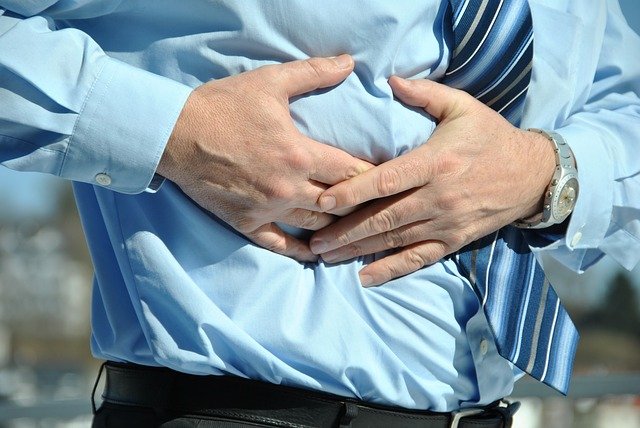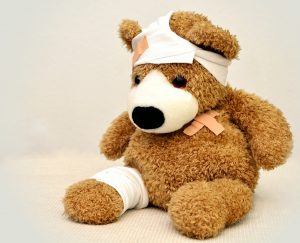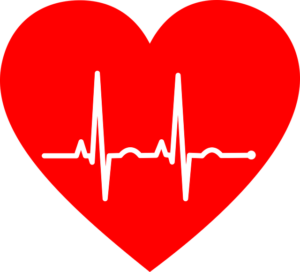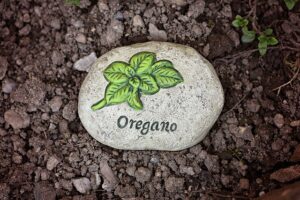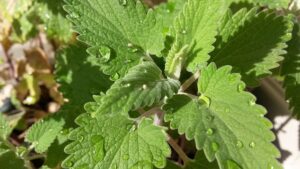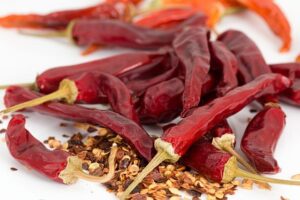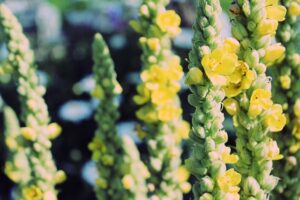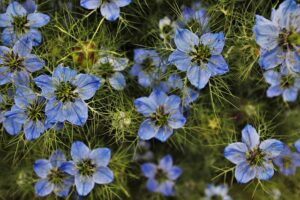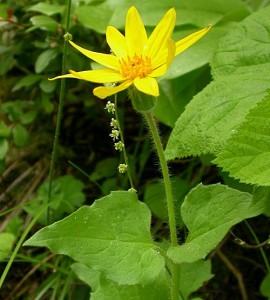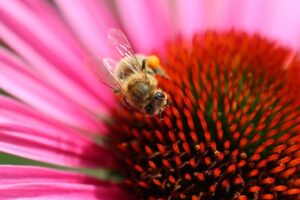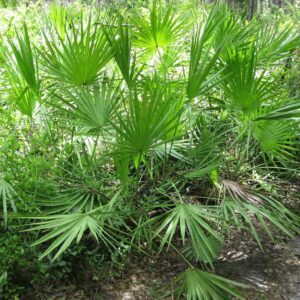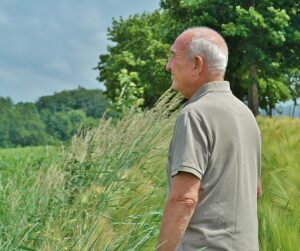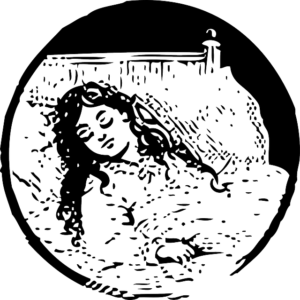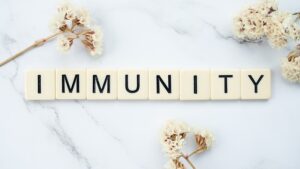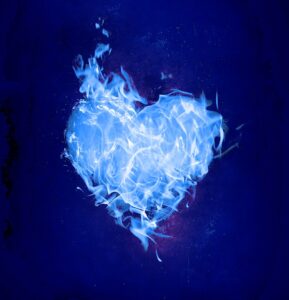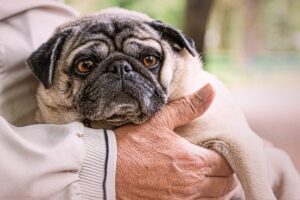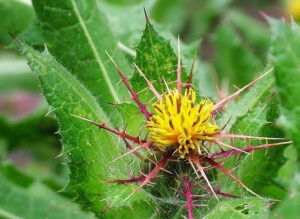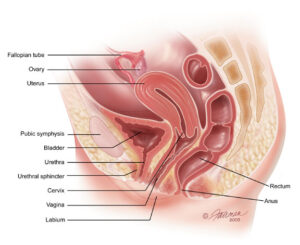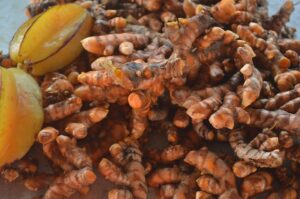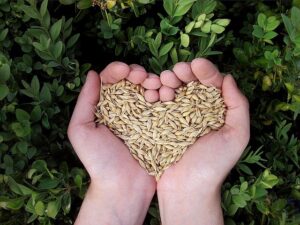Dear Annie, I have had gallbladder pain on and off for most of my adult life. For a while it seemed to go away but has been back the last few weeks. Can you help me understand what is going on? As a diabetic, I am on medication to control my blood sugar but always prefer to go natural if possible. Thank you.
Yes, thank you for your question! Herbal therapies can offer relief from gallbladder pain. First let’s take a look at gallbladder anatomy and some things that can cause gallbladder discomfort, then we can dive into natural strategies.
The following post contains affiliate links. That means, if you purchase a product through one of the links, I make a commission at no additional cost to you. I appreciate it each time you click on or make a purchase from one of my links. Thank you for your support.
Anatomy of the Gallbladder
The gallbladder is a pear-shaped, hollow organ, located in the upper right part of the abdomen, under the right lobe of the liver. It is part of the biliary system. The biliary system is part of an accessory digestive tract responsible for producing, storing, and transporting bile. Bile is a yellow/brown enzyme produced by the liver then stored in the gallbladder. Bile has several functions.
- Bile contains acids (also called bile salts) that are important for the digestion of fats and fat-soluble vitamins (like vitamins A, D, E and K).
- Bile aids digestion of proteins and starches.
- Bile helps the liver clear toxins and helps rid the body of unwanted, dangerous organisms.
- Bile helps regulate healthy gut microflora.
- Bile also stimulates peristalsis (a smooth muscle action that moves food along from the mouth to the anus).
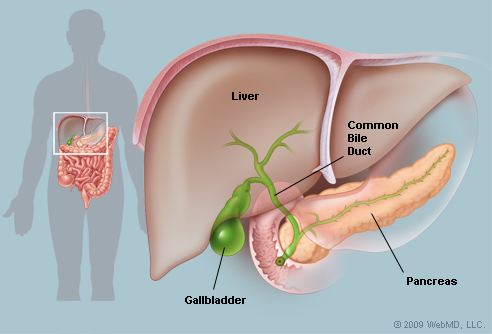
Function of the Gallbladder
The primary function of the gallbladder is to store and concentrate bile produced in the liver. When fats are eaten, the body senses it, and releases the stored bile. The bile moves through a system of ducts or small tubes and into part of the small intestine called the duodenum. Here, the bile breaks down the fats and oils into smaller particles for digestion.
Traditional Healing Philosophies about the Gallbladder
The gallbladder holds a prominent place in folk herbalism, and TCM (Traditional Chinese Medicine). In folk medicine, the gallbladder is the physical residence of the ego. We can see this represented by statements like “he has a lot of gall,” meaning that someone is acting with brazen boldness and insolence. “Yellow Belly”, is slang for cowardice, meaning someone who has too little ego or not enough “gall.” The word bile is also used in the English language to denote anger, bitterness, and irritation. When we bite back the bitterness, we “swallow our bile.”
TCM sees the gallbladder as home of the conscious will, where it governs decision making and planning. On a deeper level, the gallbladder is responsible for passion of life, inspiration, action, and assertiveness. When gallbladder energy is operating smoothly, we feel happy, healthy, assertive, and passionate. Difficulties with the gallbladder are associated with anger, frustration, resentment or on the opposite end, the gallbladder is also linked with lack of follow through and feeling timid or uninspired.
According to both traditional healing methods, gallbladder problems are associated with stuffing anger, resentment, and difficult feelings. As an interesting diagnostic point, traditional healers examine the fourth toe to see if a bunion protrudes from it, which usually indicates gallbladder imbalance.
Gallbladder Stress

A gallbladder attack is characterized by intense pain and inflammation in the upper right abdomen. The pain usually comes and goes in intervals. However, simply because there is pain, does not mean that your gallbladder is distressed. So how do we know?
Usually, there is a combination of symptoms. No one symptom is enough for a clear indication of gallbladder stress. Symptoms can range from mild or severe pain in the abdomen to a migraine headache.
Symptoms of Gallbladder Stress
- A bitter or bad taste in the mouth that will not go away, like dissolving an aspirin in your mouth.
- Nausea – the most common symptom, especially with other symptoms like a fever and a bad taste in the mouth.
- Reflexive pain under the right scapula. Although, the pain can be under either or both shoulder blades, it is most often under the right shoulder blade. This reflexive pain can move up into the neck and into the head
- Migraine headache with possible fever and sensitivity to light
- Fever
- Vomiting with the taste of bile (an extremely bitter taste)
- Pain under the ribs
- Regularly occurring heartburn or GERD at least once or twice per week
- Liver Inflammation
- Dry skin
- Widespread body pain or skin tenderness, like your skin is on fire, or like you’ve been run over by a truck, yet there is a concrete reason for the pain
- Constipation with white chalky stools or diarrhea with yellow or green stools, possibly alternating
- Mild jaundice or a yellowing of the skin, under the fingernails and eyes
- Bloating of the stomach and abdomen.
Yes, this a long list. Chances are you won’t experience all the symptoms. But if the problem is with your gallbladder, you will likely have 3 or more symptoms grouped together.
It’s important to take a good look at all the symptoms present. Sometimes, symptoms that seem unrelated are in fact from the same cause.
Causes of Gallbladder Pain
It’s all about the bile
As a hollow organ designed to store and excrete bile, the state and flow of bile reflects the health of the gallbladder. Bile is a caustic substance, designed to breakdown foodstuffs, fats and oils for digestion. When bile becomes overly concentrated, thickening and stagnation can occur, with stagnation comes inflammation, blockage, and possibly the formation stones and cysts.
Gallbladder Stagnation
If the bile becomes too thick or congealed, it has difficulty passing through bile ducts and into the small intestine. When this happens, the slow-moving caustic bile can cause inflammation and irritation to the inside wall of the gall bladder and to the bile ducts. Sometimes, a cyst or lesion can form, creating pain and sensitivity. Other times the slow-moving bile causes sensitivity due to a congestion in the bile duct.
Gallstones
Gallstones are small, hard deposits created when bile crystallizes. According to Dr Vansant Lad, bile crystallizes due to stagnation. The flow of bile slows down, becoming too thick. The healthy chemical balance of bile is altered, coagulating to the viscosity of mucus and slowly begins to crystalize.
Gallstones can range in size from as small as a grain of sand to as large as a golf ball. Most of the time, we don’t feel them. One or several gallstones can remain in the gallbladder for several years with no symptoms. However, if the stones grow too large, they can become obstructions, blocking the flow of bile through the small bile duct, resulting in a great deal of pain. Usually, when this happens, the gallbladder is removed.
Natural Solutions for Gallbladder Pain
First, Go See Your Doctor
The first thing to do if there is gallbladder pain is to talk to your doctor. An ultra-sound will show if you have stones and rule out other possible causes for your discomfort. This is an important step. Different approaches are needed if you have gallstones, simple bile stagnation, a problem with the structure or tone of the gallbladder or cysts in the biliary system. A diagnosis from your doctor is the least painful way to really understand what is going on.
With Gallstones
The intense pain of biliary colic is caused by gallstones stones trying to pass through or blocking the bile duct. In this case we want to:
- Decrease pain leading up to and during a gallbladder “attack”
- Dissolve or soften the stones
- Adjust the diet to be sure it’s supportive and nurturing in relation to the liver, gallbladder and bile
- Help bile return to its healthy balanced state.
Castor Pack
Castor oil, when absorbed through the skin stimulates blood circulation while at the same helping to relieve pain, inflammation, stagnation, and congestion. Applied in the form of a castor pack, it improves lymphatic drainage, stimulates the immune system and helps “dissolve” or eliminate growths. For this reason, castor oil packs can be used to treat individuals with weakened immune systems, toxic inflammatory states, and abnormal growths like gallstones, cysts, polyps and cancer.
I recommend using a castor pack at least 1x per day, twice is better, especially if you experience regular sensitivity, pain or have gallstones. Watch the attached video or more information on how to make and apply a castor pack.
Cabbage Tea
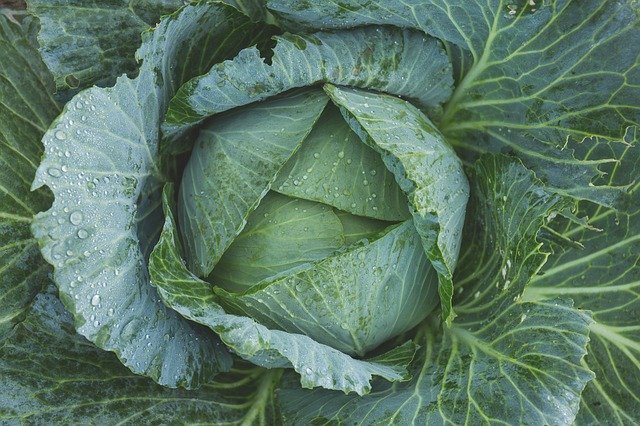
Drinking cabbage tea is a folk remedy that seems to dissolve or soften gallstones. To make the tea, tear 1 organic green cabbage leave into small pieces. Put the cabbage in a saucepan with 12 ounces of water. Bring to a rapid boil then immediately remove from heat. Let sit for 5 minutes. Strain and drink warm on an empty stomach, 15 minutes before eating or drinking anything else.
Flax Seed Tea
A simple, inexpensive, and useful remedy for all kinds of gallbladder pain is flax seed tea. Use it when you are having pain or even during an intense attack.
To make flax seed tea, place one tablespoon whole flax seeds into a saucepan with 12 oz of water and bring to a boil. Lower the temperature and simmer for 10 minutes. Stain through a fine mesh strainer and sip this tea slowly. Make sure to sip slowly while the tea is hot/warm. The consistency of flax tea is very slimy, especially as the tea begins to get cold. Plus, it tastes better hot.
Peppermint (Mentha × piperita)
Peppermint tea, commonly used as a digestive aid and can help relieve the pain of a gallbladder attack. This is because peppermint relaxes smooth muscle spasms in the lining of the gall bladder and bile ducts. Peppermint also contains a natural terpene (strongly aromatic compounds) that may help dissolve existing gallstones, although the studies are mixed in their results in this regard.
One interesting study on the use of peppermint for all sorts of digestive functions found that the use of peppermint oil inhibited contractibility and spasm in the gallbladder, duodenum, and the colon. This study suggests that prepared capsules of Peppermint oil or Peppermint tea might be useful during a gallbladder “attack” because it inhibits the emptying of bile and the spasms of the gallbladder and bile network.
Diet
Diet is an important consideration. For a good outline of the do’s and don’ts of a diet to benefit healthy gallbladder function please go here.
Gallbladder or Bile Stagnation with No Stones
When bile becomes stagnant, but there are no stones, cholagogue herbs are used to increase the flow of bile from the liver and to tone the gallbladder. In effect, this flushes the old, thickened bile from the system and replaces it with freshly made bile, which flows more easily. Many cholagogue herbs also work to increase gallbladder contractability and response to chemical and hormonal stimulus.
Some of my favorite cholagogue herbs are Celandine, Dandelion, Spreading Dog Bane, and Yellow Dock. Often listed in herbal literature as most helpful for gallbladder issues including colic, jaundice, GERD and to lower the concentration or cholesterol in bile salts are Ginger, Fringe tree bark, Milk Thistle and Turmeric.
Relief of Gallbladder Pain and Sensitivity
Herbs to relieve smooth muscle pain and colic include Wild Yam Bark, Fennel, Ginger, Jamaican Dogwood and Cramp Bark. These herbs can be combined to help relieve intense spasming of the gallbladder.
Herbs to Help Relieve Gallbladder Pain
Celandine (Chelidonium majus)
Celandine, also called Greater Celandine, is a go-to herb for gallbladder problems especially those involving bile stagnation, inflammation, and irritation of the inside walls of the gallbladder, blocked bile ducts, constipation, jaundice, and gallbladder headaches.
The herb works to tone the physical organs of the liver and gallbladder, strengthening their overall health and function. Celandine, for our purpose, is used in formula when there is pain and swelling in the area of the liver and under the right shoulder blade.
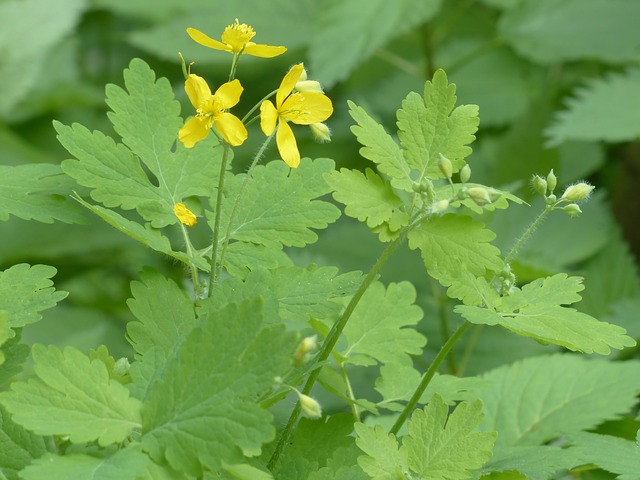
Other indications that Celandine may be called for include headaches, jaundice (a yellow discoloration of the eyes, skin, face, stool and urine), heartburn or GERD after eating a fatty meal, and/or on and off constipation with white chalky stools. Additionally, Celandine is known to remove and support the passage of gallstones. A wonderful herb.
Celandine is a low dose herb that should only be used in drop doses.
Artemisias’ including Sage Brush (Artemisia tridenanta), Holy Sage (Artemisia ludavesiana), Wormwood (Artemisia absinthium)
The Artemisias can be used interchangeably for our purpose. These are strong herbs that work well when the liver is congested, or the bile flow is blocked. Especially when using the tincture or cold tea. Sip a cup of cold tea, made with a teaspoon dried herb with 8 oz of cold water, left to steep for 1-8 hours. Or take 10-20 drops of the tincture in a class of water. Consume either preparation over the period of a few minutes. Often one dose is all that’s needed to release the tension and get things moving again.
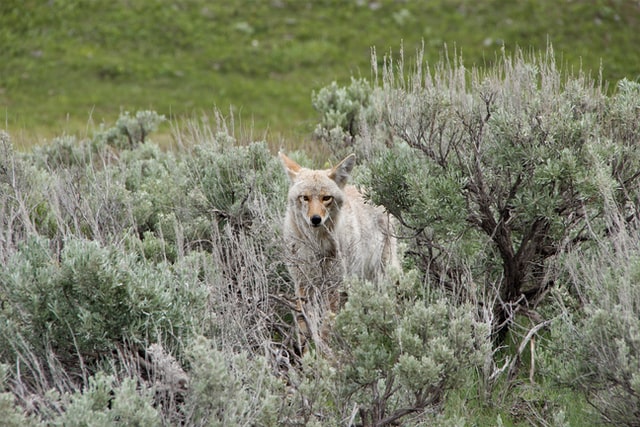
Artemisia “Sages” also work well as a warm poultice to relieve abdominal cramps. To make a poultice, put a handful (or two) of fresh or dried herb into a blender. Add enough hot water while blending to create a warm paste. Spread the paste on a clean cloth, wrapping the paste into the cloth and put it over the abdomen, or wherever it hurts. Leave in place for 30 to 90 minutes with a hot pad (on low) or a hot water bottle. As with the castor pack, one or two times per day is best.
Dandelion (Taraxacum officinalis)
What an amazing little plant. Dandelion does so much for so many parts of the body. It supports the kidneys and urinary bladder, acts as a pancreatic tonic, and of course supports the liver and gallbladder. Dandelion, especially when mixed with Orange peel and any mallow family plant (like Marshmallow Root or Hollyhock), helps soften stones in the urinary and biliary systems. I don’t know if it dissolves the stones, but it sure makes them softer and more pleasant to pass. Dandelion improves gallbladder function and bile production. According to Dr. Vansant Lad and Dr. David Frawley, “Dandelion dispels accumulated and stagnated bile,” which exactly what we need. Plus, Dandelion is a gentle, soothing, and safe herb.
Use the leaves (more bitter), or the root in a tea or tincture.
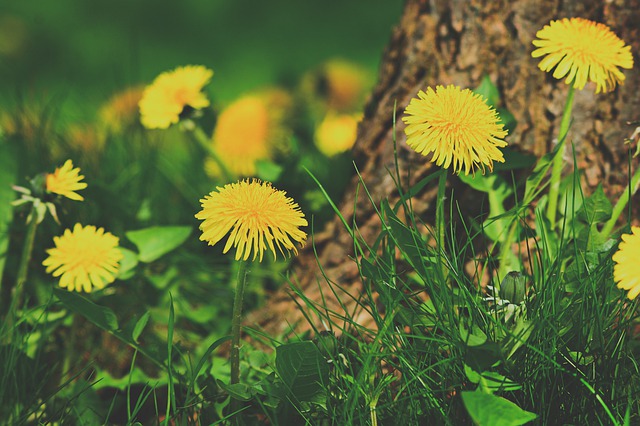
Fennel (Foeniculum vulgare)
Add fennel to a formula as a harmonizing agent to sooth and balance digestion. Fennel is one of the go-to herbs for painful colic (the spasm or cramp one feels when something is stuck and will not pass). It helps relieve inflammation in the stomach, liver, gallbladder, spleen and lower bowels. Fennel helps reduce nausea, stomach cramps, gas, and spasms and it tastes good.
Usually the seeds are used medicinally and may be used in tea or tincture.
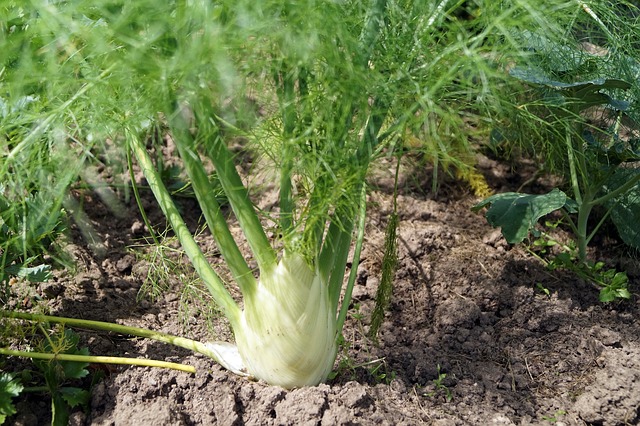
Barberry Root (Berberis vulgaris or other species)
Barberry is a bitter, stimulating digestive herb that helps to clear damp heat (like stagnant bile). It helps increase the liver’s bile production while protecting and healing mucosal tissue that lines the passages of the digestive system (like the inside of the gallbladder, bile ducts and small intestine). Additionally, this herb helps the body with the breakdown, assimilation and digestion of fats and oils.
Barberry root is most often used in a decoction (a boiled tea) or tincture, in formula.
Milk Thistle (Silybum marianum)
A tophorestorative (special healing herb) is for the liver and pancreas. Milk Thistle is a bitter tonic with astringent and demulcent properties. In relation to gallbladder issues, this herb reduces the concentration of cholesterol in bile. Thus, decreasing the likelihood of forming stone because most people who have bile stagnation and biliary stones have high cholesterol in their bile.
Spreading Dogbane (Apocynum androsaemifolium)
Samuel Thompson, one of the great herbalists of the 19th century wrote, “Apocynum is one the the greatest correctors of bile in the plant kingdom.” Dogbane strengthens the structures and ducts of the gallbladder and liver so they can function better. Its action isn’t on stimulating bile but on toning the structure of the gallbladder, allowing for a freer discharge and flow of biliary fluids. Dogbane is also used to relieve the discomfort of gall cysts or small polyps on the inside lining of the gallbladder.
Spreading Dogbane is indicated when the skin is sallow, yellowish, and clammy. The tongue will often have a yellow, bitter coating with either dark or clay colored bowel movements. According to Matthew Wood, Spreading Dogbane works best when gallbladder function is sluggish, and the pulse is below normal. This is not an appropriate herb to take when there is pain or a fever.
Drop doses of the tincture is best.

Conclusion
Gallbladder pain can be a very painful and sometimes serious condition. If you have only limited experience with herbs, it is best to talk to a qualified herbalist, and work with your healthcare practitioner to be sure you’re on the right path. I know people who have resolved gallstones without the removal of the gallbladder, but it is not an instant process. Rather, it takes dedication, an open mind, and a willingness to change. At the very least, there will need to be long term dietary changes. Additionally, issues of unresolved anger, resentment, depression, and control will need to be addressed. These are not easy issues.
We are whole, complete individuals. We are also a product of our lifestyle and environment. When a physical issue manifests, especially one that requires dedication to resolve, it is an opportunity for transformation. Looking at difficult painful issues in this light can make it a little easier to make needed changes. Life only gets better. Living is in the journey.
Please do not hesitate to contact me if you’d like to talk about this further.
Thank you for reading. It is my bliss to share my research and experiences with you. I hope the work is inspirational and helpful. Please take a few minutes, if your so inclined, to comment below to share your wisdom and experiences.
Many blessings
Annie
Suggested Products By Wonderment Gardens
Further Reading
References
https://simplyhealth.io/12-gallbladder-attack-symptoms-you-need-to-recognize-when-happening/
https://www.healthline.com/health/human-body-maps/gallbladder#1
https://www.herbstoponline.com/blogs/news/7289314-the-gallbladder-part-2#content
https://www.herbstoponline.com/blogs/news/7249848-the-gallbladder-part-1
https://bodyecology.com/articles/why_proper_bile_flow_essential_for_getting_rid_of_toxins-php/
https://www.chinesemedicineliving.com/medicine/organs/the-gallbladder/
https://www.ncbi.nlm.nih.gov/pmc/articles/PMC5814329/
https://www.rjwhelan.co.nz/herbs%20A-Z/wormwood.html
Kane, Charles W; Medicinal Plants of the American Southwest, Lincoln Town Press, 2011
Hoffman, David; The New Holistic Herbal, Element Publishing, Rockport, Massachusetts, 1990
Wood, Matthew; The book of Herbal Wisdom, Using plants as medicine. North Atlantic Books, Berkley Ca. 1997
Lad, Vansant B.A.M.S, M.A.Sc; The Complete Book of Ayurvedic Home Remedies, Three Rivers Press, NY, NY. 1998
Disclaimer
The statements and ideas presented here are not intended to diagnose, treat, cure, or prevent any disease or condition. They have not been evaluated by the FDA. All ideas presented are for the sole purpose of education. To help you take control of your own health. If you have a health concern or condition, consult a physician. We suggest that you always consult a medical doctor before modifying your diet, using any new product, drug, supplement, or doing any new exercises.
These statements and products have not been evaluated by the FDA. They are not intended to diagnose, treat, cure, or prevent any disease or condition. If you have a health concern or condition, consult a physician. Always consult a medical doctor before modifying your diet, using any new product, drug, supplement, or doing any new exercises.
Herbs taken for health purposes should be treated with the same care as medicine. Herbal remedies are no substitute for a healthy diet and lifestyle. If you are serious about good health, you’ll want to combine diet, exercise, herbals, a good relationship with your doctor and a generally healthy lifestyle. No one of these will do it alone.
This information is designed to be used as part of a complete health plan. No products are intended to replace your doctor’s care, or to supersede any of his/her advice or prescriptions.

